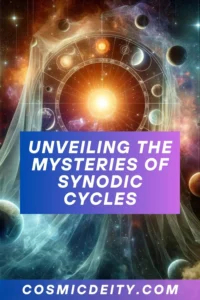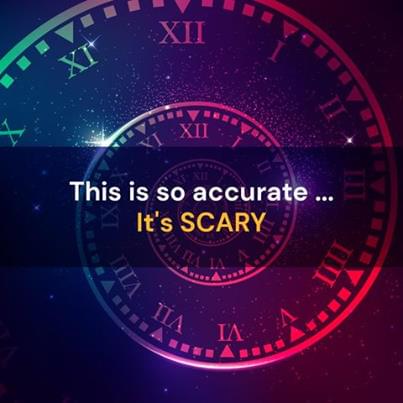Astrology, a celestial language that has captivated humanity for millennia, offers a unique perspective on the dance of the cosmos. Among its many facets, synodic cycles astrology stands out, weaving a narrative of planetary alignments and their profound impact on our earthly experience.
This article embarks on an exploratory journey into the heart of synodic cycles astrology, a path filled with cosmic rhythms and celestial wisdom.
DON’T MISS THIS! Are you ready to discover the cosmic secrets of your birth chart? Click here and unlock the mysteries of the universe with this trusted astrology service. Don’t miss out!
The Significance of Synodic Cycles
The concept of synodic cycles is a cornerstone in the study of astrology, offering profound insights into the natural rhythms of the cosmos and their impact on human life. These cycles, defined by the relationship between the Earth, the Sun, and other planets, represent a celestial dance that echoes the cyclic nature of existence. Each cycle marks a period of beginnings and endings, of growth and decline, mirroring the ebb and flow of life on Earth.
The significance of these cycles extends beyond mere astronomical phenomena; they are deeply woven into the fabric of human consciousness. Synodic cycles often coincide with significant turning points in individuals’ lives, acting as cosmic signposts that guide personal transformation and evolution. For example, the Saturn return, occurring approximately every 29.5 years, is a well-known synodic cycle that is often associated with major life changes and maturation.
On a collective level, synodic cycles have historically aligned with major societal shifts and cultural transformations. These periods can be seen as times of global awakening, where collective values and ideologies undergo profound changes. For instance, the conjunction of Jupiter and Saturn, known as the Great Conjunction, occurs every 20 years and has been historically observed to correlate with significant socio-political changes worldwide.
Understanding the significance of synodic cycles can offer a deeper comprehension of the interconnectedness between the cosmos and the tapestry of human experience. These cycles remind us that we are part of a larger, cosmic cycle, and our lives are influenced by these vast, celestial rhythms.
Interpreting Synodic Cycles
Interpreting synodic cycles is an intricate art that requires a deep understanding of astrological principles and celestial mechanics. Each cycle, characterized by the positions and movements of planets in relation to each other and the Earth, holds specific astrological meanings. Astrologers interpret these meanings to provide insights into individual lives and collective trends.
A key aspect of interpreting these cycles is understanding the specific energies and themes associated with different planetary alignments. For instance, when two planets are in conjunction (aligned in the same zodiac sign), it often signifies a new beginning or the initiation of a new cycle in the areas of life governed by those planets. Conversely, an opposition (when planets are directly opposite each other) might indicate a period of tension or challenge, requiring balance and integration of opposing forces.
Case studies and historical events are often used to illustrate how synodic cycles manifest in the real world. For example, the Uranus-Pluto squares of 2012-2015 coincided with widespread social and political upheaval, reflecting the transformative and disruptive energies of these planets.
Interpreting synodic cycles also involves personalizing these cosmic influences based on an individual’s birth chart. This personalized approach helps in understanding how these universal energies play out in one’s personal life, providing guidance for navigating through life’s challenges and opportunities.
Synodic Cycles and Zodiac Signs

Synodic cycles interact uniquely with each of the twelve zodiac signs, imparting distinct influences and lessons tailored to the characteristics of each sign. This interaction plays a crucial role in shaping the experiences and growth opportunities for individuals born under different signs.
For example, when a synodic cycle occurs in Aries, it brings forth themes of initiation, courage, and assertiveness, urging individuals to take bold steps and embrace new beginnings. Conversely, a cycle in Cancer might focus on themes of emotional security, nurturing, and family, encouraging a deeper connection with one’s roots and emotions.
Each zodiac sign offers a unique lens through which the energies of synodic cycles are experienced and expressed. A synodic cycle in Leo might inspire creative self-expression and leadership, while the same cycle in Virgo could emphasize practicality, service, and attention to detail.
Understanding the interaction between synodic cycles and zodiac signs can provide valuable insights into the collective mood and individual growth patterns during different periods. It helps in navigating through each cycle with greater awareness and alignment with the cosmic rhythms, allowing individuals to harness these energies effectively for personal development and fulfillment.
The Moon’s Role in Synodic Cycles
The Moon’s influence in synodic cycles is both profound and pervasive, playing a critical role in the ebb and flow of human emotions and experiences. As the fastest-moving celestial body in our solar system, the Moon’s position changes rapidly, making its impact on synodic cycles particularly dynamic and nuanced.
In astrology, the Moon is associated with our inner world – emotions, instincts, subconscious patterns, and personal needs. During its orbit, the Moon forms various aspects with other planets, and these interactions are key components of synodic cycles. These aspects can trigger emotional responses, bring subconscious issues to the surface, and highlight areas in our lives that need nurturing or change.
One of the most significant aspects of the Moon’s role in synodic cycles is its phases, from the new moon to the full moon. Each phase has its own unique quality and astrological significance. The new moon, for example, is traditionally seen as a time for setting intentions and starting new projects, while the full moon is often associated with culmination, realization, and emotional intensity.
Furthermore, the Moon’s transit through the different zodiac signs adds another layer of interpretation to these cycles. As it moves through each sign, it colors our emotional landscape with the qualities of that sign, offering a regular rhythm of shifting perspectives and feelings.
Sun-Moon Synodic Cycle
The Sun-Moon synodic cycle, encompassing the phases from new moon to full moon and back, is one of the most recognizable and influential cycles in astrology. This cycle is a dance between our conscious will (Sun) and our emotional and instinctual nature (Moon), playing out over approximately 29.5 days.
The new moon phase, representing the conjunction of the Sun and Moon, is a time of new beginnings. It’s an ideal period for introspection, setting intentions, and planting the seeds of future plans. This phase is often seen as a clean slate, offering a chance for renewal and starting afresh.
As the cycle progresses to the first quarter moon, we encounter a phase of action and decision-making. This is a time to overcome challenges and make necessary changes to bring our new moon intentions to fruition.
The full moon, when the Sun and Moon are in opposition, is a time of illumination and realization. It often brings clarity and awareness, highlighting the results of our efforts since the new moon. Emotions run high during this phase, as it shines a light on what needs to be released or completed.
Finally, the cycle concludes with the waning phases, a period for reflection, release, and letting go. This is a time to clear away what no longer serves us, making space for the next new moon cycle to begin.
Synodic Cycles and Relationships
Synodic cycles have a profound impact on relationships, offering a cosmic framework for understanding the dynamics between individuals. These cycles can influence how we connect with others, highlighting times of harmony, challenge, growth, and transformation within relationships.
For instance, the Venus-Mars cycle, which governs aspects of love, attraction, and action, can signify periods of heightened passion or conflict in relationships. When these planets form conjunctions or oppositions, we may find our relationships undergoing significant changes or facing crucial tests.
Similarly, the Jupiter-Saturn cycle, with its themes of growth and structure, can mark important milestones in relationships, such as the beginning of a new partnership, the deepening of commitment, or the reevaluation of long-term goals and expectations.
Understanding these cycles can provide valuable insights into the timing of relationship events, such as the best times for starting a new relationship, working on existing ones, or letting go of connections that no longer serve our growth.
Myths and Misconceptions about Synodic Cycles
There are several myths and misconceptions surrounding synodic cycles that can lead to misunderstandings about their role in astrology. One common myth is that these cycles always signify major life changes or upheavals. While synodic cycles can mark significant periods, their influence is often more subtle, guiding gradual internal growth and awareness rather than causing dramatic external events.
Another misconception is that the effects of synodic cycles are the same for everyone. In reality, the impact of these cycles varies greatly depending on an individual’s birth chart and current life circumstances. Personal resonance with a particular cycle can depend on how the planets involved interact with one’s natal chart.
There’s also a tendency to view certain synodic cycles, particularly those involving challenging aspects or retrogrades, as inherently negative or ominous. However, in astrology, all cycles and aspects are viewed as opportunities for learning and evolution. Even challenging cycles offer valuable lessons and chances for personal development.
Understanding these myths and realities helps in gaining a more nuanced and balanced perspective on the role of synodic cycles in astrology, enabling a deeper appreciation of their complex and multifaceted nature.



